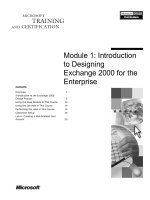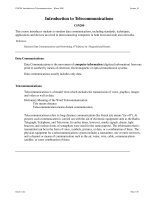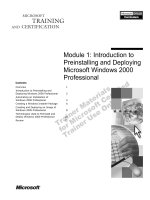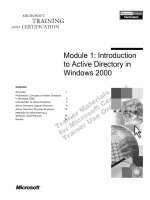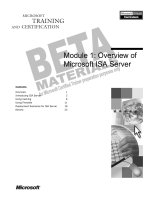Tài liệu Module 1: Introduction to Microsoft Windows 2000 File, Print, and Web Servers pdf
Bạn đang xem bản rút gọn của tài liệu. Xem và tải ngay bản đầy đủ của tài liệu tại đây (946.37 KB, 16 trang )
Contents
Module 1: Introduction
to Microsoft
Windows 2000 File,
Print, and Web Servers
Overview
1
Introduction to Windows 2000
2
Benefits of Upgrading an Existing Server
to Windows 2000
3
Benefits of a File Server Running
Windows 2000
4
Benefits of a Print Server Running
Windows 2000
5
Benefits of a Web Server Running
Windows 2000
6
Benefits of Active Directory
7
Review
9
Information in this document is subject to change without notice. The names of companies,
products, people, characters, and/or data mentioned herein are fictitious and are in no way intended
to represent any real individual, company, product, or event, unless otherwise noted. Complying
with all applicable copyright laws is the responsibility of the user. No part of this document may
be reproduced or transmitted in any form or by any means, electronic or mechanical, for any
purpose, without the express written permission of Microsoft Corporation. If, however, your only
means of access is electronic, permission to print one copy is hereby granted.
Microsoft may have patents, patent applications, trademarks, copyrights, or other intellectual
property rights covering subject matter in this document. Except as expressly provided in any
written license agreement from Microsoft, the furnishing of this document does not give you any
license to these patents, trademarks, copyrights, or other intellectual property.
2000 Microsoft Corporation. All rights reserved.
Microsoft, Active Directory, BackOffice, MS-DOS, PowerPoint, Visual Studio, Windows,
Windows Media, and Windows NT are either registered trademarks or trademarks of Microsoft
Corporation in the U.S.A. and/or other countries.
The names of companies, products, people, characters, and/or data mentioned herein are fictitious
and are in no way intended to represent any real individual, company, product, or event, unless
otherwise noted.
Other product and company names mentioned herein may be the trademarks of their respective
owners.
Project Lead and Instructional Designer: Rick Selby
Project Revision Leads: Red Johnston; Jaswinder Singh Lamba (NIIT [USA] Inc.)
Revision Development: NIIT (USA) Inc.
Instructional Designers: Victoria Fodale (ComputerPREP, Inc); Barbara Pelletier (S&T OnSite)
Program Manager: Rodney Miller
Testing Leads: Sid Benavente, Keith Cotton
Testing Developer: Greg Stemp (S&T OnSite)
Courseware Test Engineers: Jeff Clark; Jim Toland (ComputerPREP, Inc)
Graphic Artist: Julie Stone (Independent Contractor)
Editing Manager: Lynette Skinner
Editor: Kelly Baker (Write Stuff)
Copy Editor: Kathy Toney (S&T Consulting)
Online Program Manager: Debbi Conger
Online Publications Manager: Arlo Emerson (Aquent Partners)
Online Support: Eric Brandt (S&T OnSite)
Multimedia Development: Kelly Renner (Entex)
Compact Disc and Lab Testing: Data Dimensions, Inc.
Production Support: Irene Barnett (S&T Consulting)
Manufacturing Manager: Rick Terek (S&T OnSite)
Manufacturing Support: Laura King (S&T OnSite)
Lead Product Manager, Development Services: Bo Galford
Lead Product Manager: Gerry Lang
Group Product Manager: Robert Stewart
Simulations and interactive exercises were built by using Macromedia Authorware
Module 1: Introduction to Microsoft Windows 2000 File, Print, and Web Servers
iii
Instructor Notes
Presentation:
30 Minutes
Lab:
0 Minutes
This module presents an overview of Microsoft® Windows® 2000 and
introduces the features that make any of the Windows 2000 server family ideal
for use on a file server, a print server, or a Web server.
At the end of this module, students will be able to:
Describe the Windows 2000 operating systems.
Describe the benefits of upgrading an existing server to Windows 2000.
Explain the benefits that a file server running Windows 2000 offers to a
Microsoft Windows NT® version 4.0 network.
Explain the benefits that a print server running Windows 2000 offers to a
Windows NT 4.0 network.
Explain the benefits that a Web server running Windows 2000 offers to a
Windows NT 4.0 network.
Describe the benefits of the Active Directory™ directory service.
Materials and Preparation
This section provides you with the materials and preparation needed to teach
this module.
Materials
To teach this module, you need the following materials:
• Microsoft PowerPoint® file 1594B_01.ppt
Preparation
To prepare for this module, you should read all the materials for this module.
Module Strategy
Use the following strategy to present this module:
Introduction to Windows 2000
This topic provides general information about the Windows 2000 client
operating system and expanded line of server products. Describe the
different capabilities of the operating systems to help students select the best
product for their organization’s needs.
Benefits of Upgrading an Existing Server to Windows 2000
This topic describes the benefits of upgrading an existing server to
Windows 2000. Explain that when you upgrade to Windows 2000, existing
settings, users, groups, and permissions are retained. In addition, describe
the enhancements for file, print, and Web servers that an upgrade to
Windows 2000 provides to a network.
iv
Module 1: Introduction to Microsoft Windows 2000 File, Print, and Web Servers
Benefits of a File Server Running Windows 2000
This topic describes the features in Windows 2000 that enhance the file
services in Windows NT 4.0. Describe the benefits of offline files, the
Distributed file system (Dfs), the NTFS file system, and permission
enhancements.
Benefits of a Print Server Running Windows 2000
This topic identifies the features in Windows 2000 that enhance the print
services in Windows NT 4.0. Describe the benefits of increased printer
support, printer pools, and the Internet Printing Protocol (IPP).
Benefits of a Web Server Running Windows 2000
This topic describes the features in Windows 2000 that enhance the file
services in Windows NT 4.0. Describe the benefits of Internet Information
Services (IIS), Active Server Pages (ASP), and Microsoft Windows Media™
Services.
Benefits of Active Directory
This topic describes the benefits of Active Directory and how it addresses
various business needs. Explain how Active Directory addresses the
business needs of reduced total cost of ownership (TCO), simplified and
flexible administration, scalability, and standards-based protocols. In
addition, explain that Active Directory can be integrated with Dfs to allow
shared folders to be published as Active Directory objects. Finally, describe
the conditions under which printers are published as objects in Active
Directory, allowing users to locate them more easily.
Customization Information
This section identifies the lab setup requirements for a module and the
configuration changes that occur on student computers during the labs. This
information is provided to assist you in replicating or customizing Microsoft
Official Curriculum (MOC) courseware.
This module does not include any labs, and as a result, there are no lab
requirements for replication or customization.
Module 1: Introduction to Microsoft Windows 2000 File, Print, and Web Servers
1
Overview
Slide Objective
To provide an overview of
the module topics and
objectives.
Lead-in
In this module, you will learn
about the benefits of
upgrading an existing server
to Windows 2000, in
addition to the benefits that
Windows 2000 provides for
file, print, and Web servers.
Introduction to Windows 2000
Benefits of Upgrading an Existing Server to
Windows 2000
Benefits of a File Server Running Windows 2000
Benefits of a Print Server Running Windows 2000
Benefits of a Web Server Running Windows 2000
Benefits of Active Directory
You will also learn about
how Active Directory
addresses various business
needs.
Microsoft® Windows® 2000 includes enhanced services that make it ideal for
use on file, print, and Web servers in a Microsoft Windows NT® version 4.0
network. Enhanced file services improve storage management and make it
easier for users to locate and access information. Improvements to print services
provide support for more types of printers and make it easier for users to locate
printers across a network and over the Internet. Improvements to Web services
allow organizations to share information more efficiently by using the Web and
to create Web-based business applications.
Windows 2000 also includes the Active Directory™ directory service that
provides a way for users, and other clients in a distributed environment, to
name, store, and retrieve information. Active Directory enhances file and print
server functionality by publishing shared folders and printers so that users can
locate them easily.
At the end of this module, you will be able to:
Describe the Windows 2000 operating systems.
Describe the benefits of upgrading an existing server to Windows 2000.
Explain the benefits that a file server running Windows 2000 offers to a
Windows NT 4.0 network.
Explain the benefits that a print server running Windows 2000 offers to a
Windows NT 4.0 network.
Explain the benefits that a Web server running Windows 2000 offers to a
Windows NT 4.0 network.
Describe the benefits of Active Directory.
2
Module 1: Introduction to Microsoft Windows 2000 File, Print, and Web Servers
Introduction to Windows 2000
Slide Objective
To highlight the operating
systems included in
Windows 2000.
Windows 2000
Datacenter Server
Supports 32 CPUs
Windows 2000 Server
Supports 4 CPUs
Lead-in
Understanding the
capabilities of each of the
Windows 2000 operating
systems will enable you to
select the best product to
meet the current and future
needs of your organization.
Servers
Windows 2000
Advanced Server
Supports 8 CPUs
Windows 2000
Professional
Supports 2 CPUs
Workstation
The Windows 2000 operating systems build upon previous versions of
Windows by providing higher levels of security, reliability, and performance,
significantly reducing costs, enabling a new generation of applications, and
providing a solid infrastructure upon which to build a digital nervous system.
The following table describes the operating systems that are included in
Windows 2000.
Operating system
Description
Windows 2000 Professional
Replaces Microsoft Windows 95, Microsoft Windows 98, and Microsoft
Windows NT Workstation 4.0 in a business environment. It is designed for
businesses of all sizes. Windows 2000 Professional supports up to 2 CPUs.
Windows 2000 Server
Contains all of the functionality of Windows 2000 Professional, plus services
that simplify network management. This version of Windows 2000 is ideal for
file and print servers, Web servers, and workgroups, and provides improved
network access. Windows 2000 Server supports up to 4 CPUs.
Windows 2000 Advanced Server
Contains all of the functionality of Windows 2000 Server, plus increased
scalability and system availability. This version of Windows 2000 is designed
for servers that are used in a large enterprise network and for databaseintensive work. Windows 2000 Advanced Server supports up to 8 CPUs.
Windows 2000 Datacenter Server
Contains all of the functionality of Windows 2000 Advanced Server, plus
support for more memory and more CPUs per computer. This version of
Windows 2000 is the most powerful server operating system, designed for
large data warehouses, online transaction processing, and large-scale
simulations, and server consolidation projects. Windows 2000 Datacenter
Server supports up to 32 CPUs.
Note You can learn more about Windows 2000 in course 2000, Windows 2000
First Look, available free from the Microsoft Training and Certification Web
site: />
Module 1: Introduction to Microsoft Windows 2000 File, Print, and Web Servers
Benefits of Upgrading an Existing Server to
Windows 2000
Slide Objective
To identify the performance
enhancements that occur
when you upgrade an
existing server to
Windows 2000.
Lead-in
When you upgrade an
existing server to
Windows 2000, you retain
existing settings, users,
groups, and permissions.
Windows 2000 also
provides significant
performance enhancements
for file, print, and Web
servers.
Upgrading Existing Servers to Windows 2000 Provides the
Following Enhancements:
File
Server
Server
Web
Server
Improved Disk Management
Web-Based Printing Capabilities
HTTP Compression
Upgrading existing servers to Windows 2000 enables you to retain existing
settings, users, groups, and permissions. In addition, Windows 2000 provides
enhancements that make it easier to configure and increase the performance of
file, print, and Web servers on your network.
When you upgrade an existing server to Windows 2000, the following
enhancements are provided for file, print, and Web servers:
Improved disk management for file servers
Web-based printing capabilities for print servers
Hypertext Transfer Protocol (HTTP) compression for Web servers
Note To ensure that computers running Windows 95, Windows 98, or
Windows NT can be upgraded to Windows 2000, you can use the Windows
2000 Readiness Analyzer. The Windows 2000 Readiness Analyzer identifies
installed devices and applications that are known to be incompatible with
Windows 2000. You can access the Windows 2000 Readiness Analyzer at
/>
3
4
Module 1: Introduction to Microsoft Windows 2000 File, Print, and Web Servers
Benefits of a File Server Running Windows 2000
Slide Objective
To identify the features in
Windows 2000 that enhance
the file services in
Windows NT 4.0.
File Servers Running Windows 2000 Provide
the Following Features and Capabilities:
Offline Files
Offline Files
Dfs
Dfs
Lead-in
Windows 2000 includes
several features that make it
ideal for use on a file server.
Dfs
Permissions
Permissions
Enhancements
Enhancements
NTFS
NTFS
User 1
User 2
NTFS Volume
Windows 2000 provides significant enhancements to the file services in
Windows NT 4.0 that make it ideal for use on file servers. The following
features and capabilities are available on a file server that is running any of the
operating systems in the Windows 2000 server family:
Offline files. Allow you to create a local copy of the files contained in your
network folders and make them available for use while working offline.
Files are automatically updated when you reconnect to the network. Offline
files make it easier to access data when you are not connected to the
network, and ensure that the network contains the most current version of
your files.
Note The client computer must be running Windows 2000 Professional in
order to use offline files.
Distributed file system (Dfs). Supports creation of a single tree that includes
multiple file servers and shared folders in a group, making it easier for users
to find and manage data on the network.
NTFS file system. Supports file encryption, the ability to add disk space to
an NTFS volume without restarting, distributed link tracking, and per-user
disk quotas to monitor and limit disk space. During an upgrade, all existing
NTFS volumes are automatically converted to the new version of NTFS that
is used in Windows 2000.
Permission enhancements. Allow you to set and administer permissions
more easily. Permissions are inherited in folders, and it is now possible to
add a group to the list of groups that have permissions to a folder without
reapplying all subfolder permissions.
Module 1: Introduction to Microsoft Windows 2000 File, Print, and Web Servers
5
Benefits of a Print Server Running Windows 2000
Slide Objective
To identify the features in
Windows 2000 that enhance
the print services in
Windows NT 4.0.
Lead-in
Windows 2000 includes
several features that make it
ideal for use on a print
server.
Print Servers Running Windows 2000 Provide
the Following Features and Capabilities:
ed
l is h
Pub
ter1
Prin r2
te
Prin
Support for more than 2,500 Different Printers
Printer Pools that Allow Printers to be Shared Across a Network
Printing and Printer Management over the Web with IPP
Windows 2000 provides significant enhancements to the print services in
Windows NT 4.0 that make it ideal for use on print servers. The following
features and capabilities are available on a print server that is running any of the
operating systems in the Windows 2000 server family:
Enhanced printer support. Provides support for more than 2,500 different
printers, enabling print capabilities for various operating systems.
Printer pools. Allow you to configure a print server to share printers across
a network.
Internet Printing Protocol (IPP). Allows you to manage printers by using a
Web browser, to print by using a Web page, and to view print job
information in Hypertext Markup Language (HTML) format. It also allows
users to connect to printers by using a Web browser, simplifying the process
of making printer connections.
6
Module 1: Introduction to Microsoft Windows 2000 File, Print, and Web Servers
Benefits of a Web Server Running Windows 2000
Slide Objective
To identify the features in
Windows 2000 that enhance
the Web services in
Windows NT 4.0.
Lead-in
Windows 2000 includes
several features that make it
ideal for use on a Web
server.
Web Servers Running Windows 2000 Provide
the Following Features:
~~~
~~~ ~~~ ~~~
~~~
~~~~~~ ~~~
~
~~
IIS that Enables Users to Share Documents and Information across
an Intranet or the Internet
ASP that Allows You to Create Dynamic, Interactive Web Server
Applications
Windows Media Services that Allow You to Deliver High-quality
Streaming Multimedia to Users on the Internet and Intranets
Windows 2000 provides significant enhancements to the Web services in
Windows NT 4.0 that make it ideal for use on Web servers. The following
features are available on a Web server that is running any of the operating
systems in the Windows 2000 server family:
Internet Information Services (IIS). Enables users to share documents and
information across an intranet or the Internet. IIS offers Web and File
Transfer Protocol (FTP) server software for providing Transmission Control
Protocol/Internet Protocol (TCP/IP)-based publishing services.
Active Server Pages (ASP). Allow you to create dynamic, interactive Web
server applications.
Microsoft Windows Media™ Services. Allow you to deliver high-quality
streaming multimedia to users on the Internet and intranets.
Note In order for IPP to work, the IIS should be active.
Module 1: Introduction to Microsoft Windows 2000 File, Print, and Web Servers
7
Benefits of Active Directory
Slide Objective
To highlight the benefits of
Active Directory.
Active Directory
Lead-in
Active Directory stores
information about all objects
on the network.
It is a fully extensible and
scalable directory service
that provides a single
location for all published
resources.
This section is intended for
overview purposes.
Therefore, do not spend a
great amount of time
answering questions about
Active Directory.
Business Needs
Reduced TCO
Simplified Administration
Flexible Administration
Scalability
Standards-based Protocol
Ability to Locate Resources Easily
Ability to Locate Printers Easily
How Active Directory
Addresses Business Needs
Group Policy
Single Location for Resource Information
Delegation of Authority
Domains that can Contain Millions of Objects
LDAP
Integration with Dfs
Printers Published as Objects in
Active Directory
Active Directory provides a central repository for gathering and distributing
information about objects on a network, such as users, groups, and printers.
Active Directory makes this information easy to find and use, and addresses the
following business needs:
Reduced total cost of ownership (TCO). Group Policy within Active
Directory allows you to configure desktop environments and install
applications from an administrative console. This reduces the time it would
normally take to visit each computer independently to configure settings and
install applications.
Simplified administration. Active Directory provides a single location in
which you can store information about users and resources. This simplifies
administration and makes it easier for users to find resources throughout a
network.
Flexible administration. Active Directory enables you to specify the users
who will have administrative authority over portions of your network.
Scalability. Active Directory extends the features of previous Windowsbased directory services and is designed to work well in any organization
regardless of its size.
Standards-based protocol. Applications use the industry-standard
Lightweight Directory Access Protocol (LDAP) rather than proprietary
protocols to access and change information in Active Directory.
8
Module 1: Introduction to Microsoft Windows 2000 File, Print, and Web Servers
Active Directory also provides benefits for file and print servers running
Windows 2000 by addressing the following business needs:
Ability to locate resources easily
Provides significant benefits for file servers because you can integrate
Active Directory with Dfs to publish shared folders as an Active Directory
object. This allows users to perform queries in Active Directory to quickly
and easily locate resources.
Ability to maintain network efficiency
Enables you to create fault-tolerant Dfs roots, so that you can access the Dfs
structure even if a server fails. You can map a fault-tolerant Dfs root to
many servers, allowing clients to locate a server within their own site. This
makes it possible to set up a Dfs root for global networks while maintaining
network efficiency.
Ability to locate printers easily
Provides significant benefits for print servers because when you share
printers across a network, Windows 2000 publishes the printers as objects in
Active Directory by default. This makes it easier for users to locate printers
based on printer type, location, or both.
Note For Active Directory to be available, the client computers must be
running Windows 2000 Professional. Windows 95 and Windows 98 client
operating systems that use incompatible or insufficient hardware can still take
advantage of the functionality of Active Directory by using the Windows 2000
Directory Services Client. Computers running the Windows 2000 Directory
Services Client can search the directory service and use fault-tolerant Dfs.
Module 1: Introduction to Microsoft Windows 2000 File, Print, and Web Servers
9
Review
Slide Objective
To reinforce module
objectives by reviewing key
points.
Lead-in
The review questions cover
some of the key concepts
taught in the module.
Introduction to Windows 2000
Benefits of Upgrading an Existing Server to
Windows 2000
Benefits of a File Server Running Windows 2000
Benefits of a Print Server Running Windows 2000
Benefits of a Web Server Running Windows 2000
Benefits of Active Directory
1. You are currently administering a server running Windows NT 4.0. There
are more than 600 users in your organization. The user account information
of all of the users is maintained in this server. The advantages of upgrading
to a Windows 2000 Server are that:
a. Windows 2000 is designed for servers that are used in a large enterprise
network.
b. Windows 2000 contains services that simplify network management.
c. Windows 2000 replaces Microsoft Windows 95, Microsoft Windows 98,
and Microsoft Windows NT Workstation 4.0.
d. Windows 2000 provides a central repository for distributing information
by using Active Directory.
B and D are correct. In B, Windows 2000 provides services such as the
SNMP service that simplify network management.
In D, Windows 2000 includes the Active Directory directory service that
provides a way for users, and other clients in a distributed
environment, to name, store, and retrieve information.
10
Module 1: Introduction to Microsoft Windows 2000 File, Print, and Web Servers
2. The sales managers in your company carry laptops so that they can work
while traveling. These managers often have to edit confidential files. List
three ways in which a Windows 2000 file server would benefit your
company.
a. Offline files in Windows 2000 make it easy for sales managers to edit
files whether connected to the network or not.
b. Disk Quotas in Windows 2000 make it easy for sales managers to
monitor and limit the disk space used by each sales manager.
c. The sales managers can use offline files even if they have Windows 95
or Windows 98 installed on their laptops.
d. Support for file encryption in Windows 2000 helps reduce the risk of
others gaining access to confidential data in the event that the laptop is
stolen.
A, B, and D are correct. In A, offline files allow you to create a local
copy of the files contained in your network folders and make them
available for use while working offline. Files are automatically updated
when you reconnect to the network.
In B, Disk Quotas track and control disk space usage. You can
configure Windows 2000 to prevent further disk space use and log an
event when a user exceeds a specified disk space limit.
In D, the Encrypted File System (EFS) feature of Windows 2000
enables you to encrypt confidential files and folders. An unauthorized
user trying to open, copy, move, or rename your encrypted file or folder
receives an access denied message.
3. Your company currently has a comprehensive online training program,
which requires users to run multimedia applications over the company’s
intranet. Which Windows 2000 feature will enable your employees to play
streaming multimedia over the intranet?
a. Internet Information Services (IIS).
b. Distributed file system (Dfs).
c. Windows Media Services.
d. Active Server Pages (ASP).
C is Correct. With Windows Media Services, you can create, manage,
and deliver Windows Media content over an intranet or the Internet.
Windows Media Services provides Windows Media server components,
including Windows Media Administrator and Windows Media
Encoder.
Module 1: Introduction to Microsoft Windows 2000 File, Print, and Web Servers
11
4. You are currently administering a server running Windows NT 4.0. There
are more than 500 employees in your company who need to print documents
frequently. The printers are from various third party vendors and are at
different locations on the network. What enhancements to the printing
services in Windows 2000 can make it easier for users to print in your
network?
a. Users can use network printing to connect to a printer located anywhere
on the network.
b. Users can use a Web browser to locate, connect to, and manage printers
with the help of IPP.
c. When users connect to a printer, the print drivers are automatically
downloaded to the their computers.
d. Windows 2000 provides support for more than 2,500 different printers.
B and D are correct. In B, using Internet Printing Protocol (IPP), users
can print directly to a URL over an Intranet or the Internet. In
addition, Windows 2000 Advanced Server automatically generates
print-job information in HTML format so that users can view it in their
browser.
In D, Windows 2000 provides broad device and protocol support that
enables you to choose from more than 2,500 different printers.
THIS PAGE INTENTIONALLY LEFT BLANK
